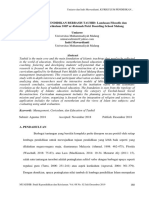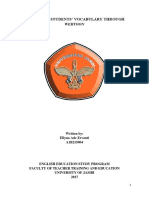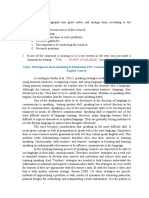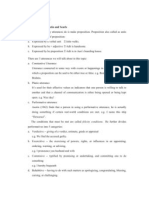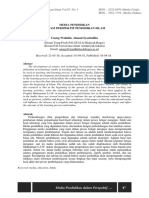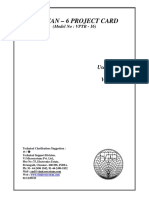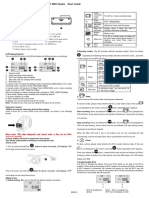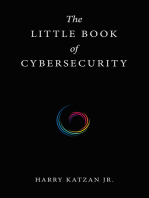Professional Documents
Culture Documents
Interactive Learning Model in Vocational Education With Smart Board Technology at Universitas Negeri Padang
Original Title
Copyright
Available Formats
Share this document
Did you find this document useful?
Is this content inappropriate?
Report this DocumentCopyright:
Available Formats
Interactive Learning Model in Vocational Education With Smart Board Technology at Universitas Negeri Padang
Copyright:
Available Formats
Volume 4, Issue 12, December – 2019 International Journal of Innovative Science and Research Technology
ISSN No:-2456-2165
Interactive Learning Model in Vocational
Education with Smart Board Technology at
Universitas Negeri Padang
Dr. Kasman Rukun
M.Pd Professor and Head of the vocational technology education in the Faculty of Engineering
Padang State University
Yasdinul Huda Muhamad Ihsan T Sriwahyuni
Student Student Student
Doktoral of Technology and Vocational Doktoral of Technology and Vocational Doktoral of Technology and Vocational
Education Faculty of Engineering Education Faculty of Engineering Education Faculty of Engineering
Padang State University Padang State University Padang State University
Abstract:- Increasing the competence of graduates to (ICT) into learning has become a serious study lately.
work according to the demands of the development of Various efforts have been made, but there is no effective
the Industrial Revolution 4.0 is determined by the role model / strategy in integrating the use of ICT equipment /
of educators. The role of educators in terms of choosing literacy, specifically the integration of the IWB Smartboard
to apply technological innovations into their learning in teaching and learning. Teaching and learning support by
with appropriate models / strategies, is considered to be integrating ICT equipment and the internet is growing and
a solution to increasing competence. The long-term goal is proven to be able to improve the competencies of
of this research is to develop an innovative and flexible students [2], then the integration of the use of Smartboard
learning model based on Smart Classroom through the IWB in learning with certain models / strategies needs to be
study of the development of an interactive learning examined.
model on technology education and vocational-based
Smart Board Technology at Padang State University. Greater ICT literacy in the form of synchronous and
This type of research is Research and Development, asynchronous learning using IWB Technology enables
with development procedures using the 4D increased collaboration and collaboration, cost
Development Model consisting of: Define, Design, effectiveness and pedagogical improvements [3]. Vast ICT
Develop and Disseminate. The model design was literacy in an intelligent learning environment is usually
validated by 3 media experts with very high validity known as a smart classroom, and this environment is seen
values; 87,35, through practicality testing on 36 students as a smart solution. The integration of the IWB Smartboard
in the Department of Electronics Engineering, the and e-learning software as an information system has
Faculty of Engineering shows that learning through the become part of the intelligent learning environment. Smart
use of IWB is more fun and interesting, and they Classroom as a modern method of education in education
claiming that it makes learning more fun and helps scenarios that provide quality education to students by
them understand difficult subjects. The developed helping them in the formation of better concepts, concept
model can be a solution to increase the competency of elaboration, increased reading skills and academic
vocational education graduates through the application achievement. E-learning software as an information system
of technology innovation strategies into the offered has been widely used by higher education institutions,
learning. including Padang State University as a platform that
supports both Synchronous and Asynchronous learning
Keywords:- Component; Industrial Revolution 4.0; TVET; types.
Interactive Learning Model; Smart Board Technology;
Smart Classroom. The teaching strategies covered in e-learning include
the use of application software, projectors and whiteboards,
I. INTRODUCTION and this has evolved into an IWB Smartboard which
combines whiteboard, computer, projector operations and
Efforts to harmonize the performance of vocational has applications to manage learning content. Synchronous
and vocational education in preparing graduates to work are learning requires lecturers and students to interact at the
increasingly in line with the demands of the development of same time can be spread geographically. On the other hand,
the Industrial Revolution 4.0 or the fourth world industrial asynchronous learning allows lecturers and lecturer-
revolution [1]. The role of educators in applying technology students to interact and participate in the educational
into their learning with appropriate models / strategies, is process at different times different [3], [4].Pedagogic
considered to be a solution to increasing competence. The changes and improving student achievement as an effect of
discovery of new models, methods, strategies in learning by the use of the IWB Smartboard are stated by [15]. The use
integrating Information and Communication Technology of the IWB Smartboard includes the possibilities offered by
IJISRT19DEC235 www.ijisrt.com 545
Volume 4, Issue 12, December – 2019 International Journal of Innovative Science and Research Technology
ISSN No:-2456-2165
ordinary whiteboards, along with other ways that enable research is to develop an innovative and flexible learning
interactive teaching and learning [9], as well as connecting model based on Smart Classroom through the study of the
to students' computers from home [16], [15]. development of interactive learning models in technology
education and vocational-based use of Smart Board
The "Smart Project" study that integrates IWB in Technology at Padang State University.
teaching and learning examines six schools with the aim of
exploring the effects of incorporating technology in In the Define phase, the activities of defining the IWB
pedagogy on teachers and students. Research findings show media as a product are carried out through field studies and
that IWB contributes significantly to parents and students, literature studies. Field studies conducted by direct
and therefore it is necessary to add Smart Classroom observation in the Department of Electronics Engineering as
throughout the school system [9]. [17] claim that the the object of research. Observations were made by
benefits of IWB are that teachers can save comments and interview. The purpose of observation is to determine the
explanations at IWB, and thus record lessons for future use media requirements that are appropriate and supportive as
by students who skip class because of absenteeism or interactive media. Analysis through literature study
illness.The application of digital technology in the activities by conducting theoretical studies through books,
classroom is one way to facilitate the learning process journals, and other sources of information related to
(Ifenthaler, &Schweinbenz, 2013).Smart Board offers planning (Design) interactive learning models using the
versatile technology with several applications (Holland, Smart Board in the Department of Electronics Engineering.
2014). Ifenthaler and Schweinbenz (2013) state that Development Phase (Development); Requirement analysis,
students can use several modalities to build knowledge. product development, is carried out after analyzing needs
Leaders need to consider all forms of technology as a and collecting work components and equipment. Analysis of
method to help students in the classroom (Sorensen et al., the needs of components and work tools adapted to product
2013). Holland (2014) suggests that the power of learning design. Product validation tests through trials are conducted
must shift from teacher to student. The benefits of the to obtain a statement of eligibility from media experts and
Smart Board range from the availability of many tools for material experts. This trial involves senior lecturers and
adding multi-media to lessons (Ifenthaler, &Schweinbenz, lecturers to evaluate the product before it is applied in
2013). Smart Board also offers interactivity in lessons and learning to test the practicality and effectiveness of the
can provide instant feedback.From the benefits noted product model. The trial results are used as input to improve
above, it can be summarized that Adopting Smart Board the product before it is disseminated.
technology into classroom lessons provides a multi-task
process for teachers and students for all students. III. RESULT
The Faculty of Engineering of Padang State University The development of learning that is modeled is by
(FT UNP) as a Technology and Vocational Education using Smart Board Tools (Interactive White Board) as the
Institute, in order to become a competitive institution in main media in classroom learning. IWB as a medium in this
responding to the Industrial Revolution 4.0 by making the research development uses the type of IWB as shown in
lecture classes at FT UNP integrated ICT programmed and Figure 1.
structured so that it is implemented into a Smart Classroom.
Some classes / laboratories at FT UNP already have
facilities to support the integration of technology to support
the creation of Smart Classroom. In order to obtain optimal
results in developing cognitive and learning skills during the
Industrial Revolution 4.0 era, the availability of several IWB
SmartBoards in the Electronic Engineering Department, is
deemed necessary to have a learning model / strategy using
an effective and integrated SmartBoard IWB with
www.elearning.unp.ac.id is being tested in this year's
research.
Fig 1:- Two Types of Interactive White Board (IWB) as the
II. METHODOLOGY Media of the Model used in the Electronic Engineering
Department
This type of research is R & D (Research and
Development), focused on the product design phase of After the interactive learning model product based on
model development conducted in the Electronic IWB is completed, then there are several stages of product
Engineering Department. The development procedure in development testing carried out through several test stages.
this study uses the 4D Model development method [4] In general there are 3 (three) test stages of this study,
consisting of: Define, Design, Develop and Disseminate. namely the level of validity, practicality, and effectiveness
The design model that was developed can be a solution to of the IWB media. as follows:
increase the competency of vocational education graduates
through the application of technological innovation
strategies in the learning offered. The long-term goal of this
IJISRT19DEC235 www.ijisrt.com 546
Volume 4, Issue 12, December – 2019 International Journal of Innovative Science and Research Technology
ISSN No:-2456-2165
A. IWB as Media Validity instrument for evaluating media validity consists of four
The learning model product was validated by experts components, namely content quality, learning quality,
consisting of 3 experts (lecturers) at FT UNP. IWB media interaction quality, and display quality. Each assessment
validation assessment instruments take the form of a indicator is given a score of one to five. The results of the
validity assessment questionnaire. The validity results are validity tests of the four components of the IWB media are
used as a guideline in revising the product to be used. The presented in Table 1.
No Assessment Components Score Criterion
IWB media Validity
1 Content Quality 86,50 Very high
2 Quality of learning 86,80 Very high
3 Quality of Interaction 88,60 Very high
4 Display Quality 87,50 Very high
Average 87,35 Very high
Table 1:- Media Expert Validation Results
The average value of the validity of using IWB Media B. IWB Media Practicality Test Results
with is 87.35, based on the Riduan (2012) validity criteria, After the validity test is done, then the next step can
it shows that the validity value is very high (in the range be done practicality test. The practicality test on the use of
81-100). During the validation process, the three validators the IWB media model is conducted on the students
provide comments and suggestions as a basis for revising participating in the course. Practicality analysis is seen
the resulting product model, so that it can be used in the based on the results of a questionnaire analysis containing
learning process. 36 students' responses. The practicality assessment
component for using the IWB model consists of 18 items of
statement instruments. The results of the practicality test
can be seen in Table 2.
No Statement Mean Std. Deviation
1 Learning with IWB is more fun 4.18 .945
2 Learning with IWB is more interesting 4.13 .972
3 I participate more actively in lessons using IWB 3.75 .978
4 I understand better in lessons using IWB 3.76 .923
5 I am more creative in learning to use IWB 3.70 .953
6 My grades are better in lessons using IWB 3.60 .947
7 I complete more work in a shorter amount of time during lessons using IWB 3.75 .988
8 I remember more from lessons using IWB 3.69 1.028
9 I prefer lessons using IWB because I learn better when I do things 3.69 1.018
10 I feel more independent in learning to use IWB 3.66 1.049
11 I work in groups in lessons using IWB 3.45 1.104
12 I don't like lessons using IWB because I don't like technology 1.87 1.230
13 Learning using IWB is useful for difficult / abstract subjects (eg, Engineering) 3.85 1.188
14 Lessons using IWB are useful for easy subjects (e.g., Language learning) 3.42 1.193
15 My lecturer is skilled in using IWB 3.34 1.129
16 My learning style fits in with lessons using IWB 3.77 .950
17 I hope we can use IWB in all lessons 3.95 1.017
18 IWB will replace conventional boards in the future 4.04 1.193
Table 2:- Practicality Test Results for IWB Media Use
Based on the data presented in Table 2, it can be express their opinions about the ability of Lecturers to use
understood that, most students think that the lessons taught IWB effectively.
using IWB are more fun and interesting. Also a large
number of students believe that the Interactive White Board This neutral response can be related to the fact that the
(IWB) will and must replace conventional class boards use of IWB in these Universities is relatively new and until
today in the future. In addition, they report that IWB plays now Students have not fully understood the dynamics of
an important role in their understanding and success in their effective dissemination and therefore may not know
difficult courses. Perhaps a strong indicator of the need to when to use them properly or not like traditional teaching
improve IWB learning at universities is a negative student methods where students usually have an opinion about the
response or strong disagreement with item 12, which effectiveness or ineffectiveness of their lecturers.
highlights students' exposure to sophisticated technology.
Students generally maintain neutrality when asked to
IJISRT19DEC235 www.ijisrt.com 547
Volume 4, Issue 12, December – 2019 International Journal of Innovative Science and Research Technology
ISSN No:-2456-2165
IV. CONCLUSION [9]. Manny-Fish, E., Dagan, O., Tikochinski, T., &
Zorman, R, “Using Interactive Whiteboard in teaching
Interactive whiteboards can make learning more real, and learning - Smart Class Pilot Project Evaluation”,
interactive, and increase student participation, motivation, Into the disciplinary Journal of E-Learning and
and concentration in the teaching and learning process. Objects Learning, 7 (1), 2011, 249-273.
Interactive whiteboard has the potential to increase the [10]. Kennewell, S., Tanner, H., Jones, S. & Beauchamp,
interaction between the teacher and students in the G, “Analysing the use of interactive technology to
classroom, where there is ICT and there are indications that implement interactive teaching”, Journal of Computer
teaching with interactive whiteboard is more fun, Assisted Learning (OnlineEarly Articles), 2007
interesting, and influences the pleasant classroom [11]. Murcia, K., & Sheffield, R, “Talking about science in
atmosphere, speed in understanding something. interactive whiteboard classrooms”, Australasian
Journal of Educational Technology, 26, 2010, 417–
The implementation of research in one year is a short 431.
time in this interesting research, so it is felt that many things [12]. Smith, H., Higgins, S., Wall, K. & Miller, J,
cannot be developed yet. The researcher suggests to other ”Interactive whiteboards: boon or bandwagon? A
researchers to investigate the relationship between students' critical review of the literature”, Journal of Computer
attitudes towards the use of IWB in education on the Assisted Learning, 21, 2005, 91–101
achievement of student learning outcomes; teacher [13]. Kozma, R. (Ed.), “Technology, innovation, and
background on attending training before or in the office educational change: A global perspective”, Eugene,
about using IWB; teaching strategies, methods and OR: International Society for Technology in
techniques used by teachers with IWB; or the suitability of Education, 2003
the software or material used with the IWB. On the other [14]. Kennewell, S, “Reflections on the interactive
hand, lecturers or teachers as practitioners and education whiteboard phenomenon: a synthesis of research from
managers are advised to use IWB to get feedback from the UK”, Paper presented at the Proceedings
students about the productivity of using IWB in their classes Australian Association for Research in Education
or educational institutions. Conference, 2006
[15]. Blau, I, “A Quiet Revolution: Interactive Whiteboards
REFERENCES At School As The Basis For Pedagogical Innovation
In The 21st Century”, In Ma'of Uma'aseh, 2012, 139-
[1]. Moch Bruri Triyono, “Tantangan Revolusi Industri Ke 156
4 (I4.0) Bagi Pendidikan Vokasi”, Semnas Voktek. [16]. Hadad, S., &Gazit, A, “Is the interactive whiteboard
2017 just a hoax? In Y. Es het-Alkalai, A. Caspi, S. Eden,
[2]. Yilmaz, M. B., &Orhan, F, “High School Students N. Geri, Y. Yair, & Y. Kalman (Eds.)”, Proceedings
Educational Usage of Internet and Their Learning of the Ch Conference for Innovation Studies and
Approaches”, World Journal on Education Tecnology, Learning ogies Technol. Raanana: Open University,
2(2), 2010. 100-112.]. 2012
[3]. Sife A., Lwoga E., and Sanga C,”New Technologies [17]. Clark D. (2012, October 2). “Interactive whiteboard or
for Teaching and Elearning; Challenges for Higher souped-up blackboard?”, available online at:
Learning Institutions in Developing Countries, http://donaldclarkplanb.blogspot.co.il/2012/10/interact
International Journal of Education and Developing ive-whiteboard-or-souped-up.html
using ICT”, 2007, Vol 3 No 2
[4]. Thiagarajan, at al., “Instructional Development For
Training Teachers of Exceptional Children : A Source
Book”, Indiana Univ, Bloomington Center for
Innovation in Teaching the Handicapped, 2016
[5]. Skills, P. f. Learning for the 21st century
skills. Tucson,: Partnership for 21st Century Skills.
[6]. Oigara, J. N., & Wallace, N, “Modeling, training, and
mentoring teacher candidates to use SMART board
technology”, Issues in Information Science and
Information Technology, 9, 2012, 297-315.
[7]. Bell, M. A. (2002a). Why use an interactive
whiteboard? A baker's dozen reasons! (Vol. 3).
Teachers.net Gazette:
http://www.teachers.net/gazette/JAN02/mabell.html.
[8]. Türel, Y. K., & Johnson, T. E, “Teachers' belief and
use of interactive whiteboards for teaching and
learning”, Journal of Educational Technology &
Society, 2012, 15(1), 381-394.
IJISRT19DEC235 www.ijisrt.com 548
You might also like
- Skripsi The Influence of Multimedia Facilities Toward Stucents' Listening SkillsDocument61 pagesSkripsi The Influence of Multimedia Facilities Toward Stucents' Listening SkillsRamdanul Barkah100% (2)
- Game Based LearningDocument37 pagesGame Based LearningPanji UntoroNo ratings yet
- Kurikulum Pendidikan Berbasis Tauhid Landasan FiloDocument30 pagesKurikulum Pendidikan Berbasis Tauhid Landasan FiloFitri MinawatiNo ratings yet
- How ELT Materials Can Facilitate Language AcquisitionDocument2 pagesHow ELT Materials Can Facilitate Language AcquisitionCindy LleraNo ratings yet
- Paper: Submitted As A Fulfilment of Assignment "Edupreneurship" The Lecturer: Anindita Badianti, M.PDDocument20 pagesPaper: Submitted As A Fulfilment of Assignment "Edupreneurship" The Lecturer: Anindita Badianti, M.PDAyu Amalia MujahidaNo ratings yet
- Proposal Kuliah Bahasa InggrisDocument30 pagesProposal Kuliah Bahasa InggrisAgus Hiday AtullohNo ratings yet
- Normann, A - 2011-Digital Storytelling in Second Language Learning. A Qualitative Study On Students (THD) PDFDocument125 pagesNormann, A - 2011-Digital Storytelling in Second Language Learning. A Qualitative Study On Students (THD) PDFmdurcetNo ratings yet
- The Effectiveness of E-Learning Madrasah in English TeachingDocument11 pagesThe Effectiveness of E-Learning Madrasah in English TeachingAndi Maya Rupa AnjeliNo ratings yet
- MISBAHUDIN-FITK CorrelationDocument62 pagesMISBAHUDIN-FITK CorrelationKmk KepriNo ratings yet
- References For Instructional DesignDocument2 pagesReferences For Instructional Designapi-26011341No ratings yet
- Execution of Speech PlanDocument8 pagesExecution of Speech PlanNur Chaulani YunusNo ratings yet
- Chapter 3Document50 pagesChapter 3Phyphi Lovito100% (2)
- Basic Process in Learning and InstructionDocument20 pagesBasic Process in Learning and InstructionFikriFauziTohaNo ratings yet
- R&D MethodologyDocument16 pagesR&D MethodologyfitriNo ratings yet
- Soal Uas English Language Testing (Jan 2021)Document1 pageSoal Uas English Language Testing (Jan 2021)Kagamine JorrisNo ratings yet
- 1 Use of Digital Technologies in Education PDFDocument359 pages1 Use of Digital Technologies in Education PDFBeverly De VegaNo ratings yet
- What Is Informal BenchmarkingDocument2 pagesWhat Is Informal BenchmarkingAna-Maria BogatuNo ratings yet
- Definition of MediaDocument10 pagesDefinition of MediaBoby SaputraNo ratings yet
- The Effectiveness of Directed Reading Techniques on Students' Reading ComprehensionDocument22 pagesThe Effectiveness of Directed Reading Techniques on Students' Reading ComprehensionFeya NuevoNo ratings yet
- Basic Competence of English SMP/MTSDocument43 pagesBasic Competence of English SMP/MTSMuhammad Ibnu SyamNo ratings yet
- The Use of Moodle E-Learning Platform: A Study in A Portuguese UniversityDocument11 pagesThe Use of Moodle E-Learning Platform: A Study in A Portuguese UniversityRatry Dwi CahyaniNo ratings yet
- Role of Psycholinguistics in Language LearningDocument21 pagesRole of Psycholinguistics in Language Learningtaw realNo ratings yet
- The Role of Parents Towards Second Language Acquisition in A Three Year Old ChildDocument10 pagesThe Role of Parents Towards Second Language Acquisition in A Three Year Old Childcitra wulanNo ratings yet
- Lack of Malaysian Values Among Youth: A 40-Character ChallengeDocument5 pagesLack of Malaysian Values Among Youth: A 40-Character ChallengeHaslan WasliNo ratings yet
- 01 The Accountant's Role in The OrganizationDocument53 pages01 The Accountant's Role in The OrganizationStpNo ratings yet
- Highlighting StrategyDocument2 pagesHighlighting Strategyapi-248208787No ratings yet
- Makalsh CMDDocument22 pagesMakalsh CMDMaudy Rahmi HasniawatiNo ratings yet
- The Difference in Language Use Among Social ClassesDocument7 pagesThe Difference in Language Use Among Social ClassescasphuiNo ratings yet
- Fossilization in Second Language LearningDocument19 pagesFossilization in Second Language Learningwinaldi 09No ratings yet
- Tugas Mata Kuliah ESPDocument12 pagesTugas Mata Kuliah ESPSuryaa Ningsihh100% (1)
- INSDSG 698 - Internship SyllabusDocument10 pagesINSDSG 698 - Internship SyllabusApostolos KoutropoulosNo ratings yet
- Example of Proposal Skripsi English PDFDocument2 pagesExample of Proposal Skripsi English PDFNancy0% (2)
- CJR PUBLIC SPEAKING-Lynes Andika HarefaDocument4 pagesCJR PUBLIC SPEAKING-Lynes Andika HarefaLynes HarefaNo ratings yet
- Organizational Development in Education and Continuing Professional Development For TeachersDocument11 pagesOrganizational Development in Education and Continuing Professional Development For TeachersCentral Asian StudiesNo ratings yet
- RPS R217 990292 15P04066 20180305222212 10948141Document12 pagesRPS R217 990292 15P04066 20180305222212 10948141Rizky RamaDhan PerDana100% (2)
- Jurnal HedonismeDocument9 pagesJurnal Hedonismeoctaberlinda6919No ratings yet
- How Drama in Teaching Can Shape Students' DevelopmentDocument3 pagesHow Drama in Teaching Can Shape Students' DevelopmentBhavani VaniNo ratings yet
- Submitted To Fulfill The Assignment of General LinguisticsDocument30 pagesSubmitted To Fulfill The Assignment of General LinguisticsLubna AssyifaNo ratings yet
- The Adoption of TikTok Application Using TAM ModelDocument15 pagesThe Adoption of TikTok Application Using TAM ModelLIM SHIAU HUINo ratings yet
- Direct Method PrinciplesDocument13 pagesDirect Method PrinciplesDian MirandaNo ratings yet
- Proposal CarDocument27 pagesProposal CarAhfi Fathia Nur HidayahNo ratings yet
- Parts of Speech GuideDocument8 pagesParts of Speech GuidemeymirahNo ratings yet
- ReflectionDocument5 pagesReflectionapi-446537912No ratings yet
- (6503) Assignment 1Document23 pages(6503) Assignment 1شیدا ٹلیNo ratings yet
- Journalism EducationDocument17 pagesJournalism EducationMariam IkramNo ratings yet
- Car-Chapter 1 EllynaDocument22 pagesCar-Chapter 1 Ellynaellyna_elvindoNo ratings yet
- Tips To Winning A Scholarship - Writing Research Proposal For Scholarship ApplicationDocument3 pagesTips To Winning A Scholarship - Writing Research Proposal For Scholarship ApplicationJhon SmithNo ratings yet
- IELTS Questions, Answers, ScriptsDocument10 pagesIELTS Questions, Answers, Scriptsanis apriliaNo ratings yet
- Critical Book Review: Lecturer: Christine Helena Natalia, S.PD., M.HumDocument13 pagesCritical Book Review: Lecturer: Christine Helena Natalia, S.PD., M.HumMutiara KholizahNo ratings yet
- Media Sosial Untuk Pembelajaran Bahasa Arab Pada Masa Pandemi: Kajian Kualitatif Penggunaan Whatsapp Pada Sekolah Dasar Di IndonesiaDocument24 pagesMedia Sosial Untuk Pembelajaran Bahasa Arab Pada Masa Pandemi: Kajian Kualitatif Penggunaan Whatsapp Pada Sekolah Dasar Di IndonesiaAy RahmaNo ratings yet
- Addal MuddinDocument81 pagesAddal MuddinSella Plk100% (1)
- Reading Sample 1Document24 pagesReading Sample 1Stephanny SylvesterNo ratings yet
- Student English Speech RulesDocument2 pagesStudent English Speech RulesCitaNo ratings yet
- LAtihan Edit Background AcakDocument4 pagesLAtihan Edit Background AcakTiara VinniNo ratings yet
- Contoh Artikel Penelitian Bahasa ArabDocument13 pagesContoh Artikel Penelitian Bahasa ArabLoviga DennyNo ratings yet
- Makalah EspDocument15 pagesMakalah EspNurma Ummach100% (1)
- Pengembangan Desain Didaktis Bahan Ajar Materi Pemfaktoran Bentuk Aljabar Pada Pembelajaran Matematika SMPDocument15 pagesPengembangan Desain Didaktis Bahan Ajar Materi Pemfaktoran Bentuk Aljabar Pada Pembelajaran Matematika SMPIkbal FansuriNo ratings yet
- Summary of Acting and Conversing SociolinguisticsDocument3 pagesSummary of Acting and Conversing Sociolinguistics'Dhe Wie'No ratings yet
- Media Pendidikan Dalam Perspektif Pendidikan IslamDocument20 pagesMedia Pendidikan Dalam Perspektif Pendidikan IslamRahmad DaniNo ratings yet
- Formulation and Evaluation of Poly Herbal Body ScrubDocument6 pagesFormulation and Evaluation of Poly Herbal Body ScrubInternational Journal of Innovative Science and Research TechnologyNo ratings yet
- Comparatively Design and Analyze Elevated Rectangular Water Reservoir with and without Bracing for Different Stagging HeightDocument4 pagesComparatively Design and Analyze Elevated Rectangular Water Reservoir with and without Bracing for Different Stagging HeightInternational Journal of Innovative Science and Research TechnologyNo ratings yet
- Explorning the Role of Machine Learning in Enhancing Cloud SecurityDocument5 pagesExplorning the Role of Machine Learning in Enhancing Cloud SecurityInternational Journal of Innovative Science and Research TechnologyNo ratings yet
- A Review: Pink Eye Outbreak in IndiaDocument3 pagesA Review: Pink Eye Outbreak in IndiaInternational Journal of Innovative Science and Research TechnologyNo ratings yet
- Design, Development and Evaluation of Methi-Shikakai Herbal ShampooDocument8 pagesDesign, Development and Evaluation of Methi-Shikakai Herbal ShampooInternational Journal of Innovative Science and Research Technology100% (2)
- Studying the Situation and Proposing Some Basic Solutions to Improve Psychological Harmony Between Managerial Staff and Students of Medical Universities in Hanoi AreaDocument5 pagesStudying the Situation and Proposing Some Basic Solutions to Improve Psychological Harmony Between Managerial Staff and Students of Medical Universities in Hanoi AreaInternational Journal of Innovative Science and Research TechnologyNo ratings yet
- A Survey of the Plastic Waste used in Paving BlocksDocument4 pagesA Survey of the Plastic Waste used in Paving BlocksInternational Journal of Innovative Science and Research TechnologyNo ratings yet
- Electro-Optics Properties of Intact Cocoa Beans based on Near Infrared TechnologyDocument7 pagesElectro-Optics Properties of Intact Cocoa Beans based on Near Infrared TechnologyInternational Journal of Innovative Science and Research TechnologyNo ratings yet
- Auto Encoder Driven Hybrid Pipelines for Image Deblurring using NAFNETDocument6 pagesAuto Encoder Driven Hybrid Pipelines for Image Deblurring using NAFNETInternational Journal of Innovative Science and Research TechnologyNo ratings yet
- Cyberbullying: Legal and Ethical Implications, Challenges and Opportunities for Policy DevelopmentDocument7 pagesCyberbullying: Legal and Ethical Implications, Challenges and Opportunities for Policy DevelopmentInternational Journal of Innovative Science and Research TechnologyNo ratings yet
- Navigating Digitalization: AHP Insights for SMEs' Strategic TransformationDocument11 pagesNavigating Digitalization: AHP Insights for SMEs' Strategic TransformationInternational Journal of Innovative Science and Research TechnologyNo ratings yet
- Hepatic Portovenous Gas in a Young MaleDocument2 pagesHepatic Portovenous Gas in a Young MaleInternational Journal of Innovative Science and Research TechnologyNo ratings yet
- Review of Biomechanics in Footwear Design and Development: An Exploration of Key Concepts and InnovationsDocument5 pagesReview of Biomechanics in Footwear Design and Development: An Exploration of Key Concepts and InnovationsInternational Journal of Innovative Science and Research TechnologyNo ratings yet
- Automatic Power Factor ControllerDocument4 pagesAutomatic Power Factor ControllerInternational Journal of Innovative Science and Research TechnologyNo ratings yet
- Formation of New Technology in Automated Highway System in Peripheral HighwayDocument6 pagesFormation of New Technology in Automated Highway System in Peripheral HighwayInternational Journal of Innovative Science and Research TechnologyNo ratings yet
- Drug Dosage Control System Using Reinforcement LearningDocument8 pagesDrug Dosage Control System Using Reinforcement LearningInternational Journal of Innovative Science and Research TechnologyNo ratings yet
- The Effect of Time Variables as Predictors of Senior Secondary School Students' Mathematical Performance Department of Mathematics Education Freetown PolytechnicDocument7 pagesThe Effect of Time Variables as Predictors of Senior Secondary School Students' Mathematical Performance Department of Mathematics Education Freetown PolytechnicInternational Journal of Innovative Science and Research TechnologyNo ratings yet
- Mobile Distractions among Adolescents: Impact on Learning in the Aftermath of COVID-19 in IndiaDocument2 pagesMobile Distractions among Adolescents: Impact on Learning in the Aftermath of COVID-19 in IndiaInternational Journal of Innovative Science and Research TechnologyNo ratings yet
- Securing Document Exchange with Blockchain Technology: A New Paradigm for Information SharingDocument4 pagesSecuring Document Exchange with Blockchain Technology: A New Paradigm for Information SharingInternational Journal of Innovative Science and Research TechnologyNo ratings yet
- Perceived Impact of Active Pedagogy in Medical Students' Learning at the Faculty of Medicine and Pharmacy of CasablancaDocument5 pagesPerceived Impact of Active Pedagogy in Medical Students' Learning at the Faculty of Medicine and Pharmacy of CasablancaInternational Journal of Innovative Science and Research TechnologyNo ratings yet
- Intelligent Engines: Revolutionizing Manufacturing and Supply Chains with AIDocument14 pagesIntelligent Engines: Revolutionizing Manufacturing and Supply Chains with AIInternational Journal of Innovative Science and Research TechnologyNo ratings yet
- Enhancing the Strength of Concrete by Using Human Hairs as a FiberDocument3 pagesEnhancing the Strength of Concrete by Using Human Hairs as a FiberInternational Journal of Innovative Science and Research TechnologyNo ratings yet
- Exploring the Clinical Characteristics, Chromosomal Analysis, and Emotional and Social Considerations in Parents of Children with Down SyndromeDocument8 pagesExploring the Clinical Characteristics, Chromosomal Analysis, and Emotional and Social Considerations in Parents of Children with Down SyndromeInternational Journal of Innovative Science and Research TechnologyNo ratings yet
- Supply Chain 5.0: A Comprehensive Literature Review on Implications, Applications and ChallengesDocument11 pagesSupply Chain 5.0: A Comprehensive Literature Review on Implications, Applications and ChallengesInternational Journal of Innovative Science and Research TechnologyNo ratings yet
- Teachers' Perceptions about Distributed Leadership Practices in South Asia: A Case Study on Academic Activities in Government Colleges of BangladeshDocument7 pagesTeachers' Perceptions about Distributed Leadership Practices in South Asia: A Case Study on Academic Activities in Government Colleges of BangladeshInternational Journal of Innovative Science and Research TechnologyNo ratings yet
- Advancing Opthalmic Diagnostics: U-Net for Retinal Blood Vessel SegmentationDocument8 pagesAdvancing Opthalmic Diagnostics: U-Net for Retinal Blood Vessel SegmentationInternational Journal of Innovative Science and Research TechnologyNo ratings yet
- The Making of Self-Disposing Contactless Motion-Activated Trash Bin Using Ultrasonic SensorsDocument7 pagesThe Making of Self-Disposing Contactless Motion-Activated Trash Bin Using Ultrasonic SensorsInternational Journal of Innovative Science and Research TechnologyNo ratings yet
- Natural Peel-Off Mask Formulation and EvaluationDocument6 pagesNatural Peel-Off Mask Formulation and EvaluationInternational Journal of Innovative Science and Research TechnologyNo ratings yet
- Beyond Shelters: A Gendered Approach to Disaster Preparedness and Resilience in Urban CentersDocument6 pagesBeyond Shelters: A Gendered Approach to Disaster Preparedness and Resilience in Urban CentersInternational Journal of Innovative Science and Research TechnologyNo ratings yet
- Handling Disruptive Behaviors of Students in San Jose National High SchoolDocument5 pagesHandling Disruptive Behaviors of Students in San Jose National High SchoolInternational Journal of Innovative Science and Research TechnologyNo ratings yet
- Advanced Excel Data Management & AnalysisDocument3 pagesAdvanced Excel Data Management & AnalysisGaurav Shankar MullickNo ratings yet
- RCCBsDocument14 pagesRCCBsE.ANANDANNo ratings yet
- All about computersDocument18 pagesAll about computersOrevelNo ratings yet
- EN 15232 - BMS For Eficiency of HVAC Buildings PDFDocument87 pagesEN 15232 - BMS For Eficiency of HVAC Buildings PDFStroe George100% (1)
- EndNote Menus Reference Guide 06-25-18Document16 pagesEndNote Menus Reference Guide 06-25-18ASSOURA BEH BRIST PASSINo ratings yet
- Gda Business: Assignment 3 INF10003 Student: Bui Vu Khanh Trang-Swh00554Document17 pagesGda Business: Assignment 3 INF10003 Student: Bui Vu Khanh Trang-Swh00554Vũ Khánh Trang BùiNo ratings yet
- BGChain WhitepaperDocument31 pagesBGChain WhitepaperJohn DamonNo ratings yet
- Information Systems Analysis: Topic 7: Process-Oriented IS MethodologiesDocument24 pagesInformation Systems Analysis: Topic 7: Process-Oriented IS MethodologiesAkuzike NgukuNo ratings yet
- External Plugin en 1.11.3Document21 pagesExternal Plugin en 1.11.3Arief Trimanda MuhammadNo ratings yet
- Annam Nisanth: Manual TestingDocument3 pagesAnnam Nisanth: Manual Testingnaga nisanthNo ratings yet
- Cryptography and Network Security: Third Edition by William Stallings Lecture Slides by Lawrie BrownDocument26 pagesCryptography and Network Security: Third Edition by William Stallings Lecture Slides by Lawrie BrownHabhaile AsfawNo ratings yet
- Ahmad RaqibDocument3 pagesAhmad RaqibMohamad IkhwanNo ratings yet
- Ti Sns50-Hba0-S01 1034097Document8 pagesTi Sns50-Hba0-S01 1034097zaleksNo ratings yet
- VR Simulation of Real & Imaginary Worlds for Specific PurposesDocument2 pagesVR Simulation of Real & Imaginary Worlds for Specific Purposesdino_020% (1)
- Pa3X Factory ResetDocument12 pagesPa3X Factory ResetAnonymous qz5pEMh44No ratings yet
- Digital Signature Security ViolationsDocument5 pagesDigital Signature Security ViolationsPratiksha SonawaneNo ratings yet
- Thesis Power System SecurityDocument8 pagesThesis Power System Securitytsfublhld100% (2)
- Manual Tecnico InglesDocument6 pagesManual Tecnico InglesyuleysNo ratings yet
- Advanced AI Planning With Devika: New Open-Source Devin AlternativeDocument7 pagesAdvanced AI Planning With Devika: New Open-Source Devin AlternativeMy SocialNo ratings yet
- Aying TechnoDocument2 pagesAying TechnoEvaNo ratings yet
- Nti P/N: E-Stsm-E7: RJ45-FF Coupler (Supplied)Document1 pageNti P/N: E-Stsm-E7: RJ45-FF Coupler (Supplied)Diana LopezNo ratings yet
- 1.4 NN MP Neuron ModelDocument20 pages1.4 NN MP Neuron ModelSatyam RanaNo ratings yet
- Yealink W52P V73 - 27 User GuideDocument98 pagesYealink W52P V73 - 27 User GuideAleksey MarmiloNo ratings yet
- RPA Automation Boosts Efficiency With BotsDocument3 pagesRPA Automation Boosts Efficiency With BotsMila TanNo ratings yet
- Spartan - 6 Project Card: User ManualDocument81 pagesSpartan - 6 Project Card: User ManualunchalliNo ratings yet
- Denver Ac-5000w Mk2 - EnglishDocument2 pagesDenver Ac-5000w Mk2 - EnglishPrva CetaNo ratings yet
- A Power Line Communication Tutorial Challenges andDocument17 pagesA Power Line Communication Tutorial Challenges andzeeshanmianNo ratings yet
- 6 1 1 Procedures Recording Qualitative DataDocument2 pages6 1 1 Procedures Recording Qualitative DataRhenmar Morales GalvezNo ratings yet
- Kioti Daedong RX6030, RX6630, RX7330, RX7630 Tractors Service Manual 07-2015Document19 pagesKioti Daedong RX6030, RX6630, RX7330, RX7630 Tractors Service Manual 07-2015LisakolyNo ratings yet
- Digital Circuits and Logic Design Lecture OverviewDocument42 pagesDigital Circuits and Logic Design Lecture Overviewramanaidu1No ratings yet
- A-level Biology Revision: Cheeky Revision ShortcutsFrom EverandA-level Biology Revision: Cheeky Revision ShortcutsRating: 5 out of 5 stars5/5 (5)
- Quantum Physics for Beginners: Simple Illustrated Guide to Discover with Practical Explanations the Paradoxes of the Life and Universe Reconsidering RealityFrom EverandQuantum Physics for Beginners: Simple Illustrated Guide to Discover with Practical Explanations the Paradoxes of the Life and Universe Reconsidering RealityRating: 2 out of 5 stars2/5 (1)
- How to Think Like a Lawyer--and Why: A Common-Sense Guide to Everyday DilemmasFrom EverandHow to Think Like a Lawyer--and Why: A Common-Sense Guide to Everyday DilemmasRating: 3 out of 5 stars3/5 (1)
- Nature-Based Learning for Young Children: Anytime, Anywhere, on Any BudgetFrom EverandNature-Based Learning for Young Children: Anytime, Anywhere, on Any BudgetRating: 5 out of 5 stars5/5 (1)
- An Introduction to the Periodic Table of Elements : Chemistry Textbook Grade 8 | Children's Chemistry BooksFrom EverandAn Introduction to the Periodic Table of Elements : Chemistry Textbook Grade 8 | Children's Chemistry BooksRating: 5 out of 5 stars5/5 (1)
- On Teaching Science: Principles and Strategies That Every Educator Should KnowFrom EverandOn Teaching Science: Principles and Strategies That Every Educator Should KnowRating: 4 out of 5 stars4/5 (2)
- Lower Secondary Science Workbook: Stage 8From EverandLower Secondary Science Workbook: Stage 8Rating: 5 out of 5 stars5/5 (1)
- How to Teach Nature Journaling: Curiosity, Wonder, AttentionFrom EverandHow to Teach Nature Journaling: Curiosity, Wonder, AttentionRating: 4.5 out of 5 stars4.5/5 (3)
- A-Level Chemistry Revision: Cheeky Revision ShortcutsFrom EverandA-Level Chemistry Revision: Cheeky Revision ShortcutsRating: 4 out of 5 stars4/5 (5)
- Simple STEAM: 50+ Science Technology Engineering Art and Math Activities for Ages 3 to 6From EverandSimple STEAM: 50+ Science Technology Engineering Art and Math Activities for Ages 3 to 6No ratings yet
- The Big Book of Nature Activities: A Year-Round Guide to Outdoor LearningFrom EverandThe Big Book of Nature Activities: A Year-Round Guide to Outdoor LearningRating: 5 out of 5 stars5/5 (3)
- Stay Curious and Keep Exploring: 50 Amazing, Bubbly, and Creative Science Experiments to Do with the Whole FamilyFrom EverandStay Curious and Keep Exploring: 50 Amazing, Bubbly, and Creative Science Experiments to Do with the Whole FamilyNo ratings yet
- Making and Tinkering With STEM: Solving Design Challenges With Young ChildrenFrom EverandMaking and Tinkering With STEM: Solving Design Challenges With Young ChildrenNo ratings yet
- The Sky Above and the Mud Below: Lessons from Nature Preschools and Forest KindergartensFrom EverandThe Sky Above and the Mud Below: Lessons from Nature Preschools and Forest KindergartensNo ratings yet
- GCSE Biology Revision: Cheeky Revision ShortcutsFrom EverandGCSE Biology Revision: Cheeky Revision ShortcutsRating: 4.5 out of 5 stars4.5/5 (2)
- Cool Science Experiments for Kids | Science and Nature for KidsFrom EverandCool Science Experiments for Kids | Science and Nature for KidsNo ratings yet



